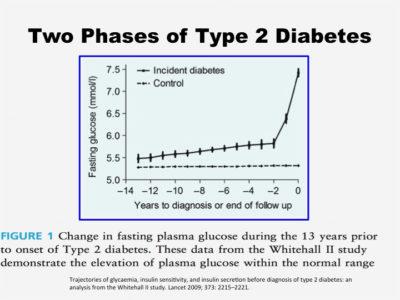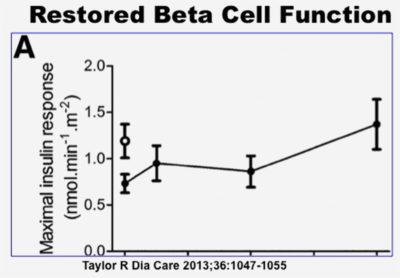
Type 2 diabetes actually happens in two phases. The first phase, which lasts approximately 10-15 years shows a slow increase in insulin resistance. However, the body compensates by increasing insulin levels. This keeps blood glucose relatively normal.
But something suddenly changes after approximately a decade of rising insulin resistance. Hyperinsulinemia can no longer keep up with the pace of insulin resistance. Pancreatic beta cells, responsible for insulin production are unable to keep up. As this compensatory mechanism fails, the blood glucose rises quickly. It takes only two years or so before full-blown type 2 diabetes is diagnosed.

One thought is that hyperglycemia destroys the beta cells. But there's an obvious problem. During the development of type 2 diabetes, blood glucose stays relatively controlled. Not until after beta cell dysfunction develops does the glucose go way up. The beta cell dysfunction caused the high blood sugars, not the other way around. This crucial point is often forgotten or ignored - especially by academic physicians and people focused on type 1 diabetes such as Dr. Bernstein.
Others have suggested inflammation or free radicals as the mechanism. However, none of these theories can explain how type 2 diabetes is so readily reversible with dietary changes. The use of anti-inflammatory or anti-oxidant medications is useless in the treatment of type 2 diabetes. That is, if free radicals caused the T2D, why does dietary change reverse it where anti-oxidants are completely useless?
The prevailing concept is the pancreatic beta cells are simply worn out from massively overproducing insulin for so long. Like a decrepit engine that has been revved too many times, irreversible damage is done over many years by the excessive workload. Certainly some evidence exists to support this concept, but only in the very end stages of type 2 diabetes. Autopsy studies occasionally show scarred and fibrotic beta cells in the pancreas of long standing diabetics.
However, three main problems exist with this paradigm. First, the suggestion that beta cells are irreversibly damaged and function is permanently lost is clearly false in the vast majority of cases. Studies of bariatric surgery and weight loss have conclusively shown that type 2 diabetes is reversible and therefore the beta function can be recovered even in massively obese patients with decades of disease. Further, Dr. Roy Taylor, of the Newcastle University in the UK specifically demonstrated pancreatic function recovering with an ultra-low calorie diet. There is no permanent burnout in most cases.

Finally, with excessive use, the body generally responds with increased, not decreased function. If you exercise a muscle it gets stronger, it doesn't burn out. With overactive secretion, glands generally get larger, not smaller. If you think too much, you get smarter. Your brain doesn't burn out. It takes decades of over-activity to produce scarring and fibrosis.
The same holds true for the insulin producing cells. They should grow larger (hypertrophy) and not smaller (atrophy). The rising epidemic of type 2 diabetes in children and adolescents clearly proves this concept false.
So, here's the million-dollar question. What causes the beta cell dysfunction in the first place? Recent research has identified the likely culprit. Fatty liver and fatty muscles produced the increased insulin resistance. Fatty pancreas creates the beta cell dysfunction. The pancreas is clogged with fat.
-
Jason Fung
Earlier with Dr. Jason Fung
All posts by Dr. Jason Fung, M.D.More with Dr. Fung
Dr. Fung has his own blog at intensivedietarymanagement.com. He is also active on Twitter.
His book The Obesity Code is available on Amazon.

His new book, The Complete Guide to Fasting is also available on Amazon.


